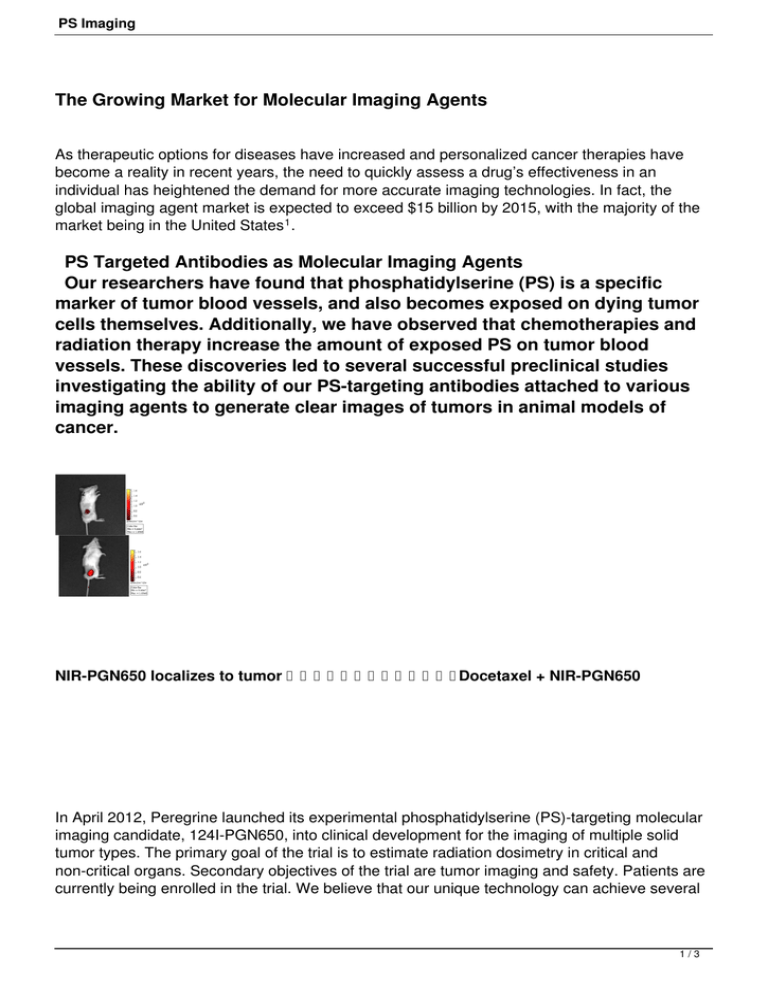PS Imaging - Peregrine Pharmaceuticals, Inc.
advertisement

PS Imaging The Growing Market for Molecular Imaging Agents As therapeutic options for diseases have increased and personalized cancer therapies have become a reality in recent years, the need to quickly assess a drug’s effectiveness in an individual has heightened the demand for more accurate imaging technologies. In fact, the global imaging agent market is expected to exceed $15 billion by 2015, with the majority of the market being in the United States 1 . PS Targeted Antibodies as Molecular Imaging Agents Our researchers have found that phosphatidylserine (PS) is a specific marker of tumor blood vessels, and also becomes exposed on dying tumor cells themselves. Additionally, we have observed that chemotherapies and radiation therapy increase the amount of exposed PS on tumor blood vessels. These discoveries led to several successful preclinical studies investigating the ability of our PS-targeting antibodies attached to various imaging agents to generate clear images of tumors in animal models of cancer. NIR-PGN650 localizes to tumor Docetaxel + NIR-PGN650 In April 2012, Peregrine launched its experimental phosphatidylserine (PS)-targeting molecular imaging candidate, 124I-PGN650, into clinical development for the imaging of multiple solid tumor types. The primary goal of the trial is to estimate radiation dosimetry in critical and non-critical organs. Secondary objectives of the trial are tumor imaging and safety. Patients are currently being enrolled in the trial. We believe that our unique technology can achieve several 1/3 PS Imaging important milestones, including: - Further validation of bavituximab’s therapeutic target Images in humans delineating the specificity of exposed PS in tumors could further validate and support PS as a promising new therapeutic target for antibody therapy across multiple tumor types, and also support PS-targeting antibodies and fragments as potential candidates for antibody-drug conjugates (ADC). - Evaluating the effectiveness of cancer therapies Since cells expose PS on their surface when they are dying, cancer treatments that are killing tumor cells will cause an increase in PS exposure in the tumor. Therefore, PS-targeted imaging agents may have the ability to image the anti-tumor effectiveness of potentially any cancer therapy. This could facilitate optimization of therapies for individual patients, where a patient may remain on a therapy that appears to be effective, or quickly switch to a different therapy if a response is not observed. - Companion diagnostic to bavituximab therapy The amount of exposed PS on tumor blood vessels may be indicative of bavituximab’s potential to initiate a robust immune response to cancer. PS-targeting imaging agents may therefore hold potential as companion diagnostics to select optimal patients for bavituximab treatment. About 124 I-PGN650 124 I-PGN650 is a first-in-class phosphatidylserine (PS)-targeting F(ab’) 2 fully human monoclonal antibody fragment joined to the PET imaging radio-isotope iodine-124 ( 124 I) that represents a new approach to imaging cancer. PS is a molecule usually located inside the membrane of healthy cells, but "flips" and becomes exposed on the outside of cells that line tumor blood vessels, creating a specific target for the imaging of multiple solid tumor types. In preclinical studies, 124 2/3 PS Imaging I-PGN650 accumulates in tumor vasculature and provides exceedingly clear in vivo tumor images. Click here to review our PS imaging data 1. Global Industry Analysts, Inc: Imaging Agents: A Global Strategic Business Report 3/3


